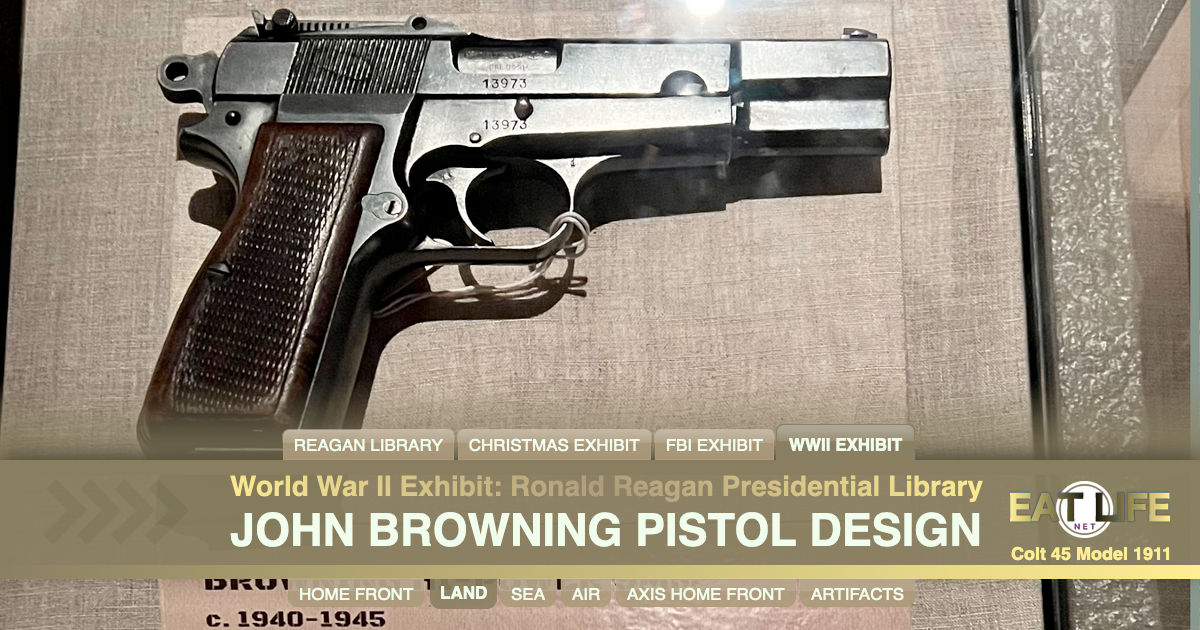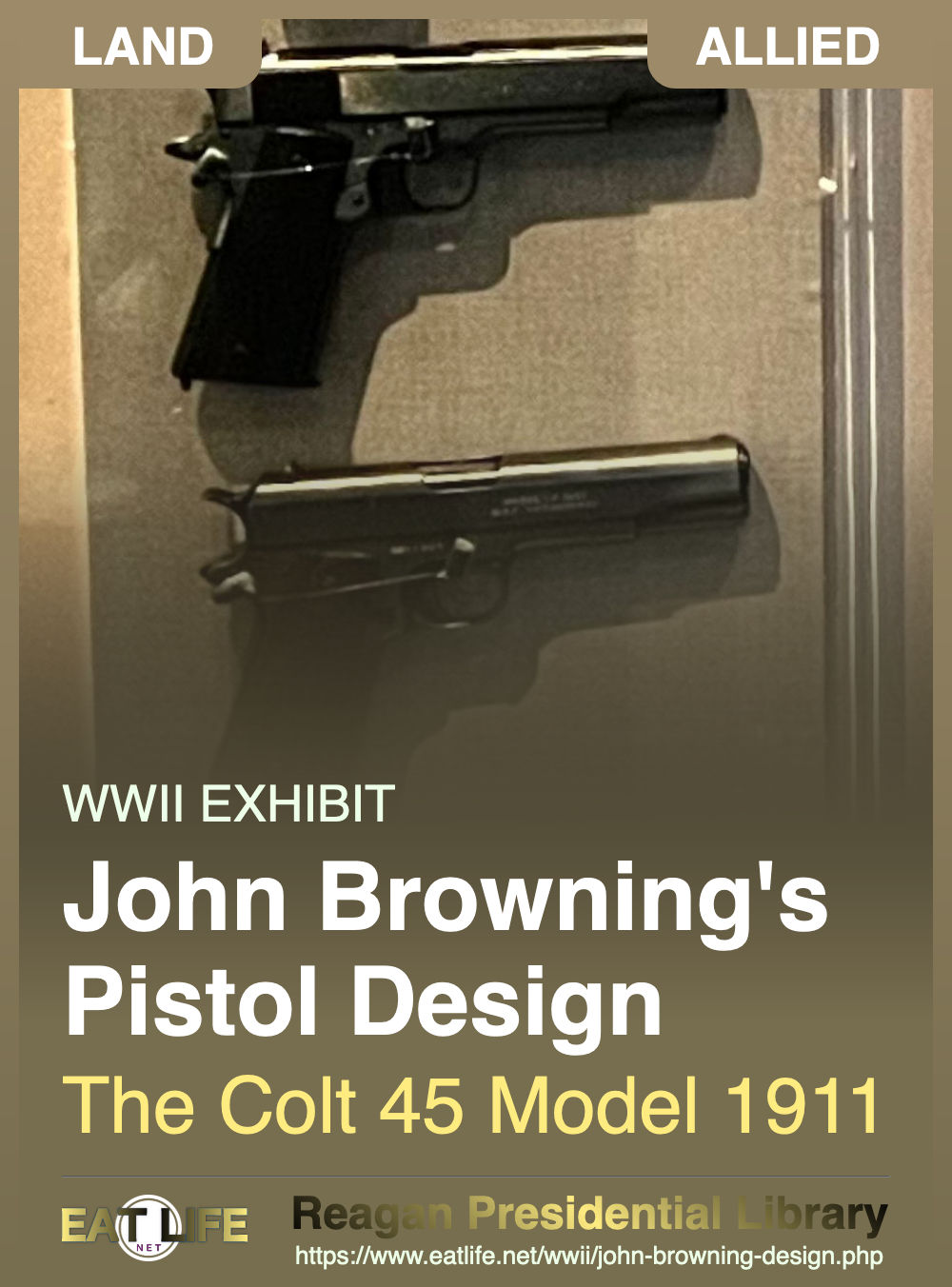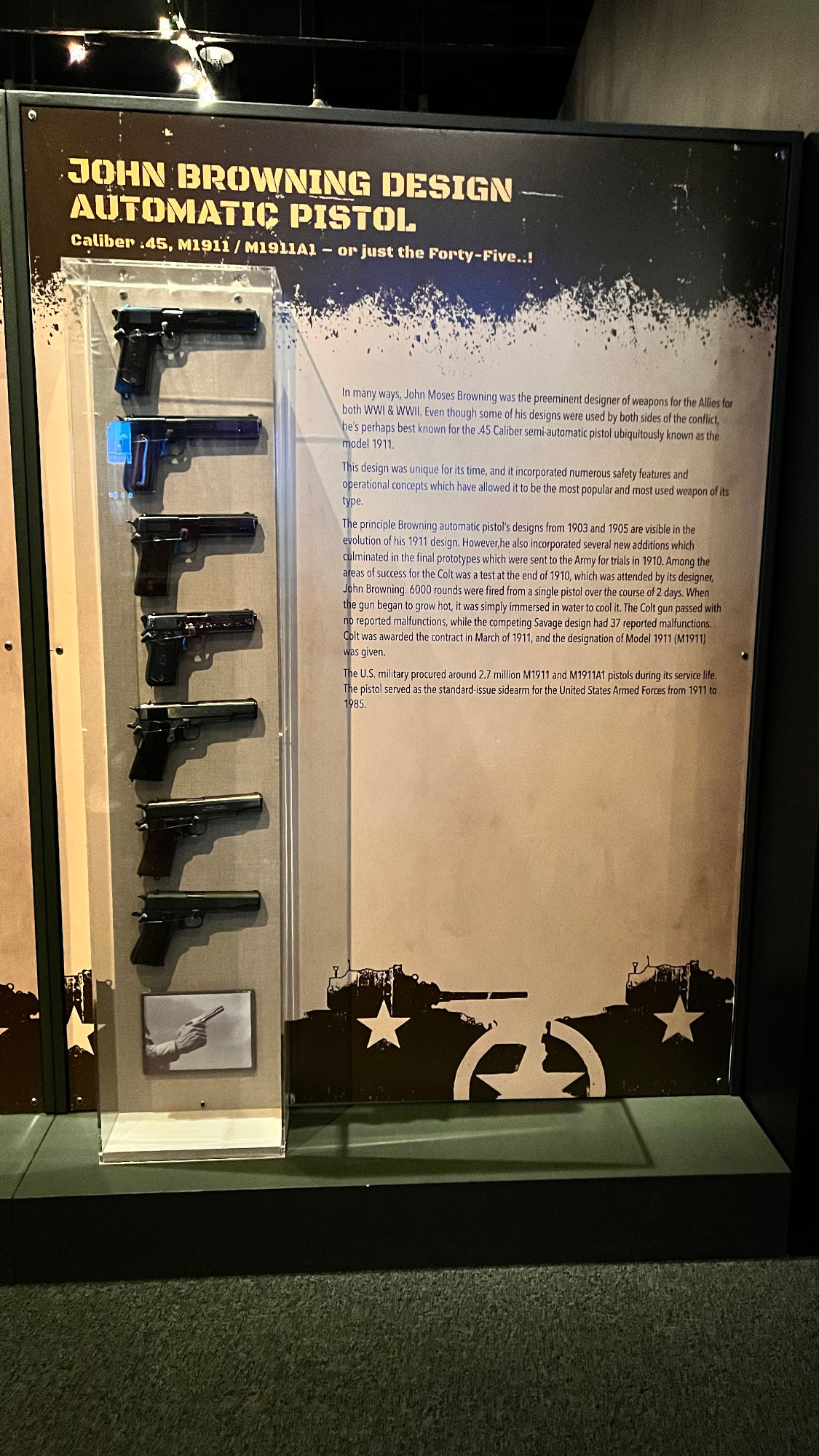
Caliber. 45, M1911 / M1911A1 - or just the Forty-Five..!
In many ways, John Moses Browning was the preeminent designer of weapons for the Allies for both WWI & WWII. Even though some of his designs were used by both sides of the conflict, he's perhaps best known for the .45 Caliber semi-automatic pistol ubiquitously known as the model 1911.
This design was unique for its time, and it incorporated numerous safety features and operational concepts which have allowed it to be the most popular and most used weapon of its type.
The principle Browning automatic pistol's designs from 1903 and 1905 are visible in the evolution of his 1911 design. However, he also incorporated several new additions which culminated in the final prototypes which were sent to the Army for trials in 1910. Among the areas of success for the Colt was a test at the end of 1910, which was attended by its designer, John Browning. 6000 rounds were fired from a single pistol over the course of 2 days. When the gun began to grow hot, it was simply immersed in water to cool it. The Colt gun passed with no reported malfunctions, while the competing Savage design had 37 reported malfunctions. Colt was awarded the contract in March of 1911, and the designation of Model 1911 (M1911) was given.
The U.S. military procured around 2.7 million M1911 and M1911A1 pistols during its service life. The pistol served as the standard-issue sidearm for the United States Armed Forces from 1911 to 1985.
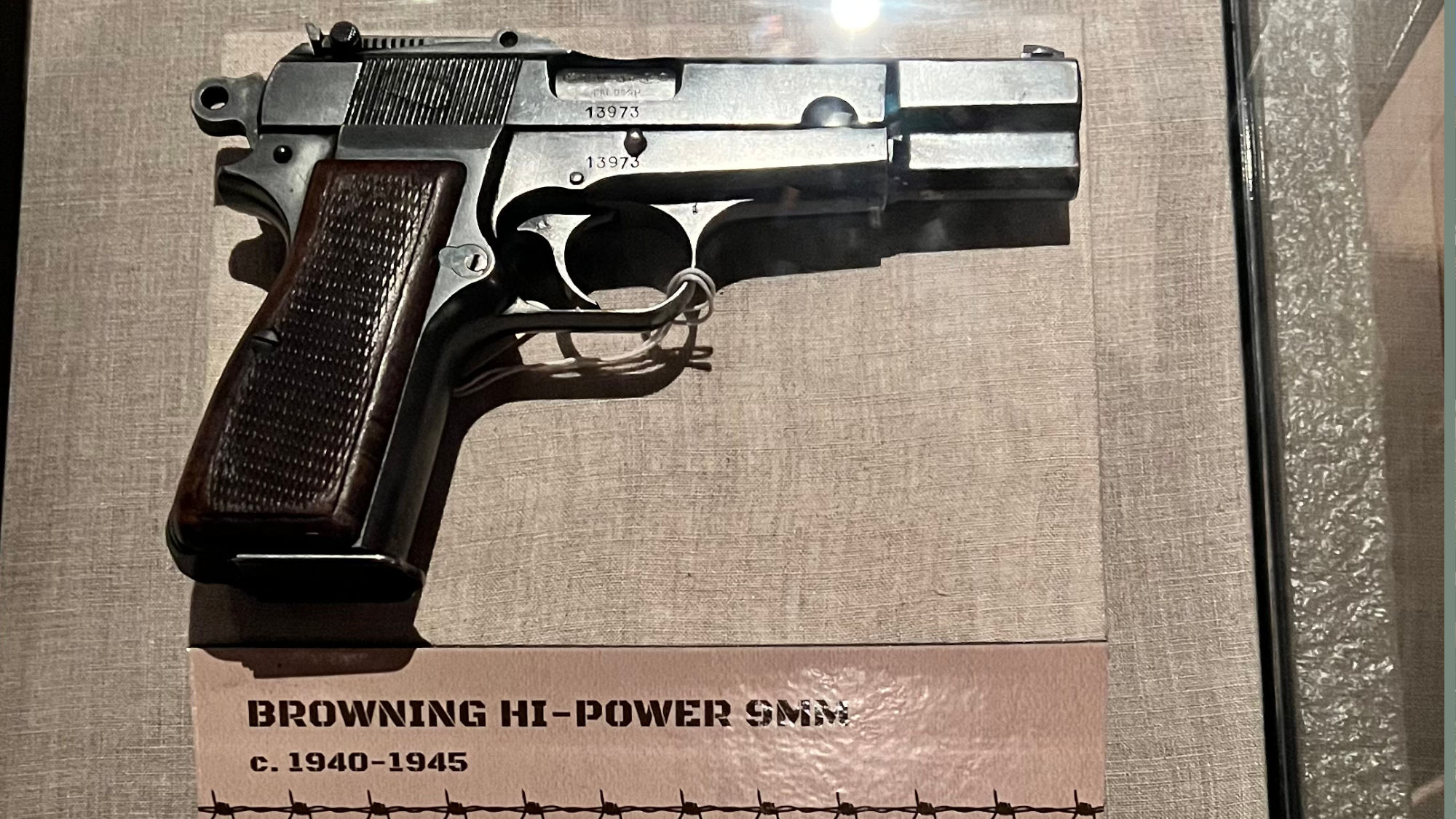
1940-1945 This gun is based on a design by American firearm designer John Browning, but was manufactured in Belgium by Fabrique Nationale for German use.
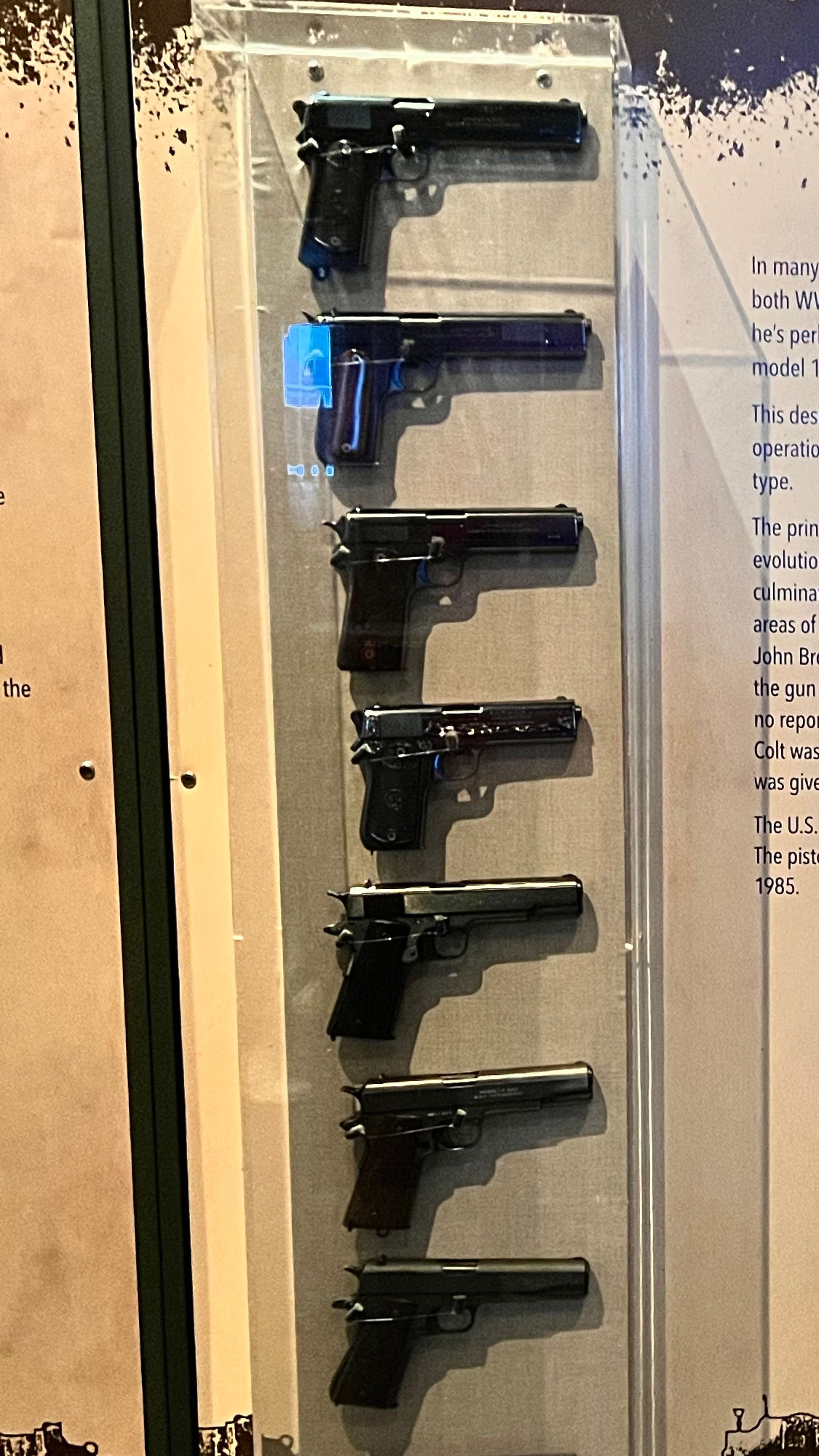
History.comThe Father of Modern Firearms
Born in Ogden, Utah on January 23, 1855
Many of the guns manufactured by companies whose names evoke the history of the American West - Winchester, Colt, Remington, and Savage - were actually based on John Browning's designs.The son of a talented gunsmith, John Browning began experimenting with his own gun designs as a young man. When he was 24 years old, he received his first patent, for a rifle that Winchester manufactured as its Single Shot Model 1885. Impressed by the young man's inventiveness, Winchester asked Browning if he could design a lever-action-repeating shotgun. Browning could and did, but his efforts convinced him that a pump-action mechanism would work better, and he patented his first pump model shotgun in 1888.
Fundamentally, all of Browning's manually-operated repeating rifle and shotgun designs were aimed at improving one thing: the speed and reliability with which gun users could fire multiple rounds-whether shooting at game birds or other people. Lever and pump actions allowed the operator to fire a round, operate the lever or pump to quickly eject the spent shell, insert a new cartridge, and then fire again in seconds.
By the late 1880s, Browning had perfected the manual repeating weapon; to make guns that fired any faster, he would somehow have to eliminate the need for slow human beings to actually work the mechanisms. But what force could replace that of the operator moving a lever or pump? Browning discovered the answer during a local shooting competition when he noticed that reeds between a man firing and his target were violently blown aside by gases escaping from the gun muzzle. He decided to try using the force of that escaping gas to automatically work the repeating mechanism.
Browning began experimenting with his idea in 1889. Three years later, he received a patent for the first crude fully automatic weapon that captured the gases at the muzzle and used them to power a mechanism that automatically reloaded the next bullet. In subsequent years, Browning refined his automatic weapon design. When U.S. soldiers went to Europe during WWI, many of them carried Browning Automatic Rifles, as well as Browning's deadly machine guns.
During a career spanning more than five decades, Browning's guns went from being the classic weapons of the American West to deadly tools of world war carnage. Amazingly, since Browning's death in 1926, there have been no further fundamental changes in the modern firearm industry.
WIKIPEDIAM1911
Colt 1911 / Colt Government
A single-action, recoil-operated, semi-automatic pistol chambered for the .45 ACP cartridge. The pistol's formal U.S. military designation as of 1940 was Automatic Pistol, Caliber .45, M1911 for the original model adopted in March 1911, and Automatic Pistol, Caliber .45, M1911A1 for the improved M1911A1 model which entered service in 1926. The designation changed to Pistol, Caliber .45, Automatic, M1911A1 in the Vietnam War era.Designed by John Browning, the M1911 is the best-known of his designs to use the short recoil principle in its basic design. The pistol was widely copied, and this operating system rose to become the preeminent type of the 20th century and of nearly all modern centerfire pistols. It is popular with civilian shooters in competitive events such as the International Defensive Pistol Association and International Practical Shooting Confederation.
The U.S. military procured around 2.7 million M1911 and M1911A1 pistols during its service life. The pistol served as the standard-issue sidearm for the United States Armed Forces from 1911 to 1985. It was widely used in World War I, World War II, the Korean War, and the Vietnam War. The M1911A1 was replaced by the adoption of the 9mm Beretta M9 pistol as the standard U.S. military sidearm in 1985. However, the U.S. Army did not replace the M1911A1 with the Beretta M9 until October 1986, and due to the M1911's popularity among users, it has not been completely phased out. Modernized derivative variants of the M1911 are still in use by some units of the U.S. Army Special Forces, U.S. Marine Corps and the U.S. Navy.
World War II and the years leading up to it created a great demand. During the war, about 1.9 million units were procured by the U.S. Government for all forces, production being undertaken by several manufacturers, including Remington Rand (900,000 produced), Colt (400,000), Ithaca Gun Company (400,000), Union Switch & Signal (50,000), and Singer (500). New M1911A1 pistols were given a parkerized metal finish instead of bluing, and the wood grip panels were replaced with panels made of brown plastic. The M1911A1 was a favored small arm of both US and allied military personnel during the war, in particular, the pistol was prized by some British commando units and Britain's highly covert Special Operations Executive, as well as South African Commonwealth forces.
The M1911A1 pistol was produced in very large quantities during the war. At the end of hostilities the government cancelled all contracts for further production and made use of existing stocks of weapons to equip personnel. Many of these weapons had seen service use, and had to be rebuilt and refinished prior to being issued. From the mid-1920s to the mid-1950s thousands of 1911s and 1911A1s were refurbished at U.S. arsenals and service depots. These rebuilds consisted of anything from minor inspections to major overhauls. Pistols that were refurbished at government arsenals will usually be marked on the frame/receiver with the arsenal's initials, such as RIA for Rock Island Armory or SA for Springfield Armory.
Among collectors today, the Singer-produced pistols in particular are highly prized, commanding high prices even in poor condition.
WIKIPEDIAJohn Moses Browning
January 23, 1855 – November 26, 1926
He was an American firearm designer who developed many varieties of military and civilian firearms, cartridges, and gun mechanisms – many of which are still in use around the world. He made his first firearm at age 13 in his father's gun shop and was awarded the first of his 128 firearm patents on October 7, 1879, at the age of 24. He is regarded as one of the most successful firearms designers of the 19th and 20th centuries and pioneered the development of modern repeating, semi-automatic, and automatic firearms.Browning influenced nearly all categories of firearms design, especially the autoloading of ammunition. He invented, or made significant improvements to, single-shot, lever-action, and pump-action rifles and shotguns. He developed the first reliable and compact autoloading pistols by inventing the telescoping bolt, then integrating the bolt and barrel shroud into what is known as the pistol slide. Browning's telescoping bolt design is now found on nearly every modern semi-automatic pistol, as well as several modern fully automatic weapons. He also developed the first gas-operated firearm, the Colt–Browning Model 1895 machine gun – a system that surpassed mechanical recoil operation to become the standard for most high-power self-loading firearm designs worldwide. He also made significant contributions to automatic cannon development.
Browning's most successful designs include the M1911 pistol, the water-cooled M1917, the air-cooled M1919, and heavy M2 machine guns, the M1918 Browning Automatic Rifle, and the Browning Auto-5 – the first semi-automatic shotgun. Some of these arms are still manufactured, often with only minor changes in detail and cosmetics to those assembled by Browning or his licensees. The Browning-designed M1911 and Hi-Power are some of the most copied firearms in the world.







